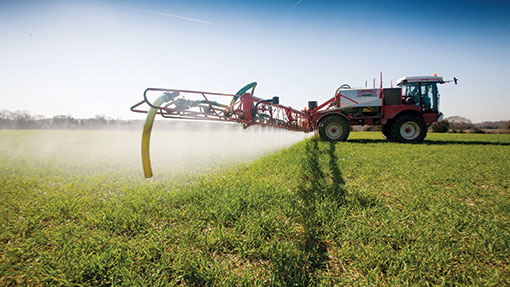Advice on spring herbicide use to control broad-leaved weeds

Growing conditions, restrictions on sequencing and cut-off dates are likely to dictate spring herbicide use to control broad-leaved weeds in cereal crops this season. Louise Impey reports on the lastest advice.
Despite the amount of herbicide that was applied before Christmas, some tidying up of broad-leaved weeds will be required this spring, especially after the wet winter.
This season’s generally well-established autumn-sown crops will be competitive and help crowd out many weeds, although record rainfall in January may have affected some herbicides.
“The very wet winter does mean the length of activity of residuals might be curtailed,” warns Nick Myers, national agronomy manager at advisory group ProCam.
Various combinations of products and sequences already used will have had an effect on broad-leaved weeds, even though their main target was grassweeds.
Mr Myers highlights cleavers, chickweed and poppy as potential problems this spring – with the added consideration that some poppy populations are resistant to sulfonylurea herbicides.
Parts of East Anglia and the North, up into Scotland, are the areas most affected by this resistance.
“This is where there’s a need to involve some of the older herbicides, such as the hormone or phenoxy products. And these need warmer conditions, with active weed growth, to work well,” he says.
Combinations of active ingredients are preferred, but it is essential to look at what has already been applied to the crop, so there are no breaches of sulfonylurea restrictions, he warns.
“If you’ve already used two of these products – perhaps flupyrsulfuron pre-emergence followed by Atlantis, for example – then you can’t use another,” he explains.
For these situations, he suggests an early-season product based on fluroxypyr, which utilises different chemistry.
“Where you still have the chance to use a sulfonylurea, then you can use fluroxypyr in mixtures with florasulam and clopyralid, as in Hunter and Spitfire,” he says.
See more: Effective spring cropping aids weed control
Early removal of cleavers is important, he stresses, although grassweeds are the first priority if their control is outstanding.
“If you’re going through the crop, look at what you can add to the tank to help with broad-leaved weeds,” he says.
Otherwise, the optimum timing for broad-leaved weed control is around GS30, or the T0 fungicide timing, Mr Myers suggests.
Cleavers are the broad-leaved weed most likely to need controlling this spring, agrees Christine Lilly, technical manager at fellow adviser Frontier Agriculture.
“With the exception of late-drilled crops, most have had their all-important grassweed control done,” she points out. “And the robust programmes used will have had an effect on broad-leaved weeds, too. But cleavers tend to escape the grassweed products.”
This means growers must consider what they have already applied before formulating their spring herbicide plans.
“The sulfonylureas are the main issue when it comes to sequencing. You can’t use two of these products on broad-leaved weeds if you’ve already applied one in the autumn,” she says.
In fact, the current restriction is for just two sulfonylureas to be applied in one growing season, explains Ms Lilly.
“So if a Lexus/Atlantis sequence has been used against blackgrass, you can’t then use a product containing metsulfuron, for example, in the spring,” she says.
Where there’s only been one sulfonylurea application to date, her preference is for a metsulfuron-based herbicide such as Ally Max or Biplay, or a thifensulfuron product such as Harmony M or Concert, partnered with either CMPP or HBN, in the spring.
“You can spray this type of mixture from February onwards, once you’ve seen some active growth. Your choice of partner will depend on the other weeds present,” she adds.
CMPP should be the partner where groundsel and charlock need controlling, while HBN is preferred if poppy and pansy are present, Ms Lilly recommends.
“Both of these herbicides like warmer weather. They won’t be very effective if the weeds are still purple and hardened off. And they have a latest application timing of GS32-33, which is earlier than it is for metsulfuron,” she adds.
She warns against mixing MCPA with manganese nitrate. “In general, the phenoxy herbicides don’t tank mix as well.”
Where grassweed control is still to be completed, resist the temptation to mix any of these products with Atlantis.
“A separate application is better for grassweeds. The pyroxsulam-based products can be tank-mixed without antagonism, but they don’t tend to give quite the same level of blackgrass control,” Ms Lilly says.
If thistles need suppressing later on there’s an opportunity to use MCPA, but only certain brands can be applied at the later timing.
“Easel is one of those. It can be used up to GS39 in wheat,” she says. Easel is also a useful option on resistant poppies. “It lets you move away from sulfonylureas and use a different mode of action.”
In spring cereal crops, herbicide choice is similar. “Products such as Boxer (florasulam) and Starane (fluroxypyr) come into the frame as you have a bit more time for control,” she explains.
The big difference with spring-germinating broad-leaved weeds is that they can be seen.
“You have a visual target. In the autumn, the residual herbicides used tend to go on ahead of the weeds,” Ms Lilly adds.
Catching up
Where no pre-emergence treatments have been applied – perhaps in late-drilled crops after roots – there’s a need to move quickly, stresses John Cussans, weed biology specialist with crop consultant NIAB TAG.
“Go on now, or as soon as you can travel, with either Crystal or one of the picolinafen products. That will give you some broad-leaved weed activity,” he says.
Growers should accept they may have to come back for cleavers as he says there’s a choice of products with good activity against cleavers and more time to use them.
“The various combinations of products and sequences used will have had an effect on broad-leaved weeds, even though their main target was grassweeds,” Dr Cussans adds.

